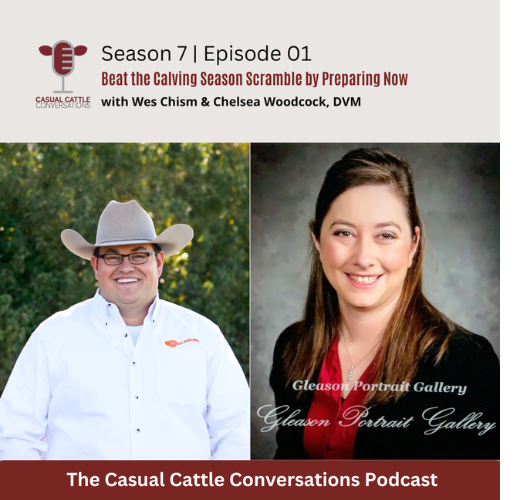The Casual Cattle Conversations Podcast: Beat the Calving Season Scramble by Preparing Now
Thursday, January 4, 2024
Reference: Podcast Corner

Beat the Calving Season Scramble by Preparing Now
January 1, 2024 | Written By Shaye Koester
Chelsea Woodcock, DVM and Wes Chism discuss what cattle producers need to keep in mind to ensure optimum herd health during their spring calving season. This episode of Casual Cattle Conversations covers the topics of when to vaccinate calves, the Sandhills calving method, what supplies to have on hand and what records are critical to track during calving season.

Click Here to listen to Shaye's Podcast
Nutrition and Vaccinations
Herd health ultimately starts before your calving season begins. Chelsea Woodcock, DVM urges cattle producers to take feed samples and make sure their nutrition program is on track to keep their cows at an adequate body condition score. She also reminds cattle producers to take extra care of their young cows and heifers that are still growing to their own mature weight while carrying a calf. “I think it goes all the way back to making sure that she's at an appropriate body condition score going into that calving season, because we know about 30 days is where she's going to hit that prime of milking and everything else. First calf heifers tend to be the ones that take the biggest hit. They're still growing and trying to maintain their own body condition and growth rate long with trying to grow a calf alongside them. So taking into account of the body condition and make sure you're supplementing the right amount of nutrition is critical,” said Woodcock.In addition to nutrition, vaccination protocol is another factor to consider. Dr. Woodcock touches on the importance of making sure you give your cows their pre-breeding shots and not vaccinating calves until they are 4 weeks of age if at all possible, to ensure vaccines are fully effective. Other herd health tips to keep in mind for a successful calving season include moving bred cows away from pairs using the Sandhills calving method and looking at your herd health records each year to make sure you aren’t having a chronic illness that should be treated in a different way.
Calving Supplies to Have on Hand
The calving supplies you have on hand will depend on the size of your herd. For larger cattle producers, Woodcock recommends having OB sleeves, lube, chains, handles and a calf jack for any hard pulls. Keeping towels around to dry off and warm up calves and iodine to dry up umbilical cords is also encouraged. However, the most important supply to have on hand is colostrum. In an ideal world cows and heifers would be able to provide this and all calves would be up and sucking within 1-2 hours of being born. But, we don’t live in an ideal world and making sure calves have the antibodies provided by colostrum within 12 hours of birth is essential to their long-term health and performance.What Data to Record During Calving
Data. Data. Data. It’s not just a buzzword. It is essential. Find a system that works for you. It can be anything from the traditional red pocketbook to a completely digital system. Whatever data system you decide to use, make sure you are recording calf birth dates, tag numbers, who their dam is and if anything was abnormal about their birth. If you are a seedstock producer, you are likely going to be recording birth weights and udder scores as well. After you record these initial data points, be sure to take note of any treatment records and key dates like bull turnout as well. “Keeping those records is really important. When you have these records, you know how many times you've treated a certain calf, and what percent of calves you are treating. Knowing this percentage level will help you determine if you are having an outbreak and need to consult with your veterinarian to create a better treatment and prevention plan,” said Woodcock.Additionally, Chism notes that keeping accurate records in combination with a good scale is critical to cutting down on input costs. These tools allow you to treat an animal with the exact dosage required and make all-around more informed management decisions.
Overall, ensuring you have a successful calving season is a year-long process. Work with your veterinarian and a nutritionist to make sure your herd health and nutrition plans are on track and find a record-keeping system that is efficient and effective for everyone on your operation. Happy calving!
Sign up to stay connected
- News
- Property Alerts
- Save your favourite properties
- And more!
Joining Farm Marketer is free, easy and you can opt out at any time.
